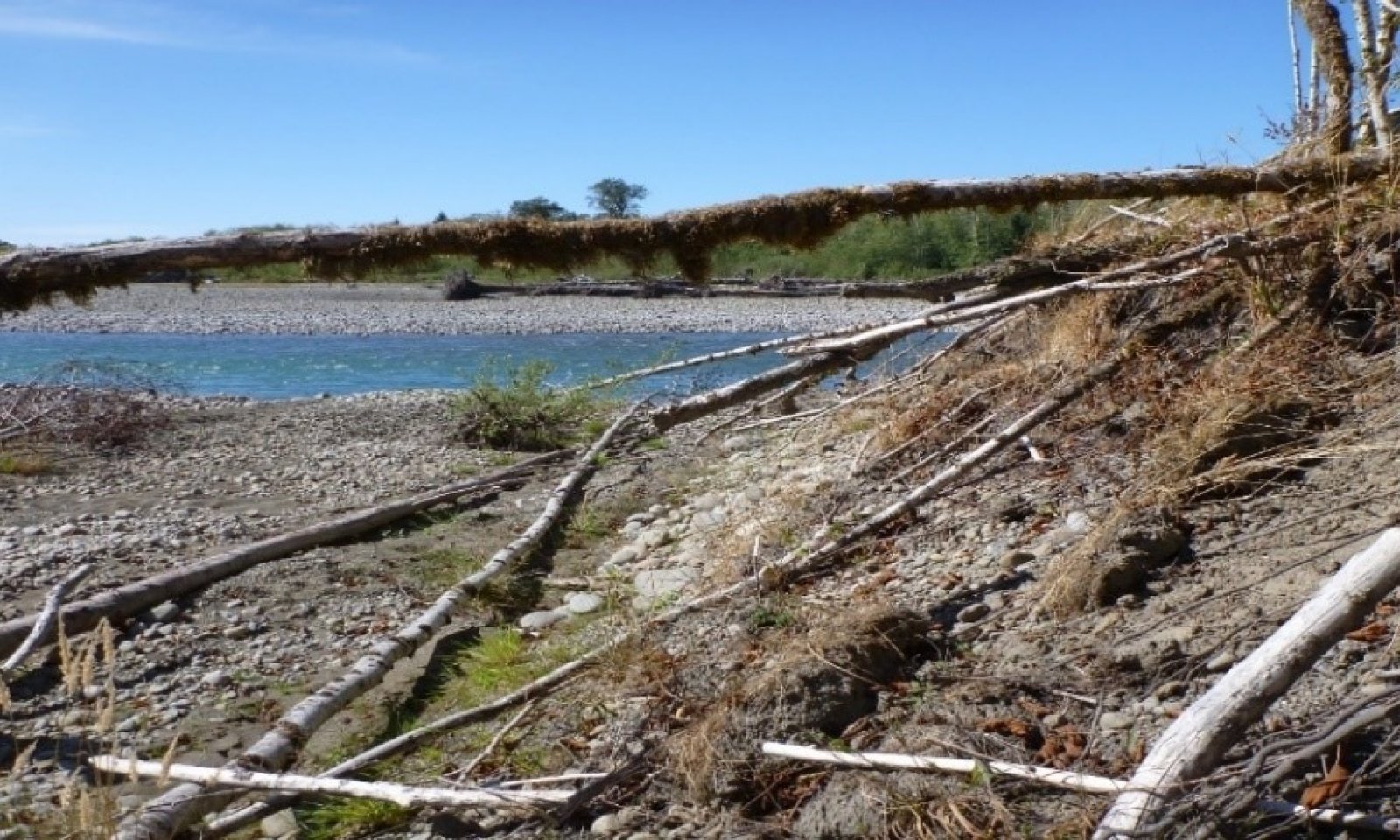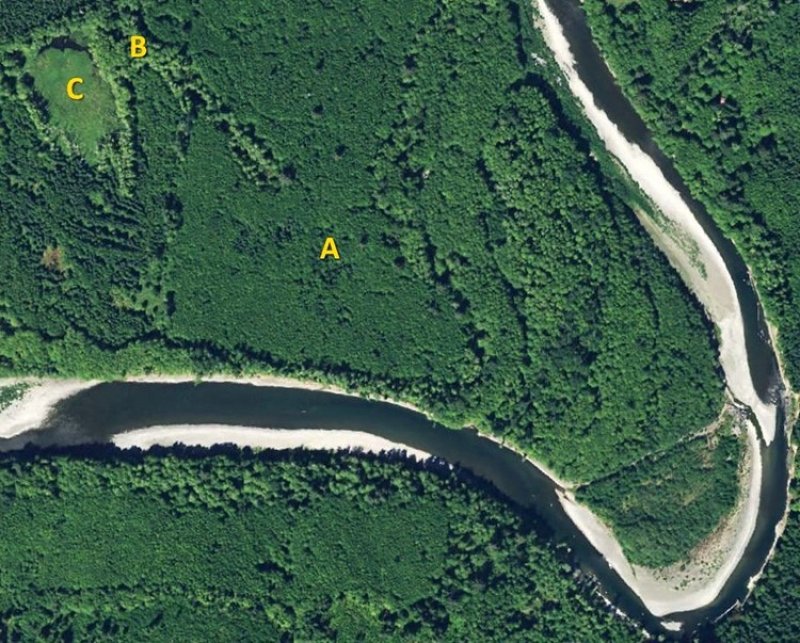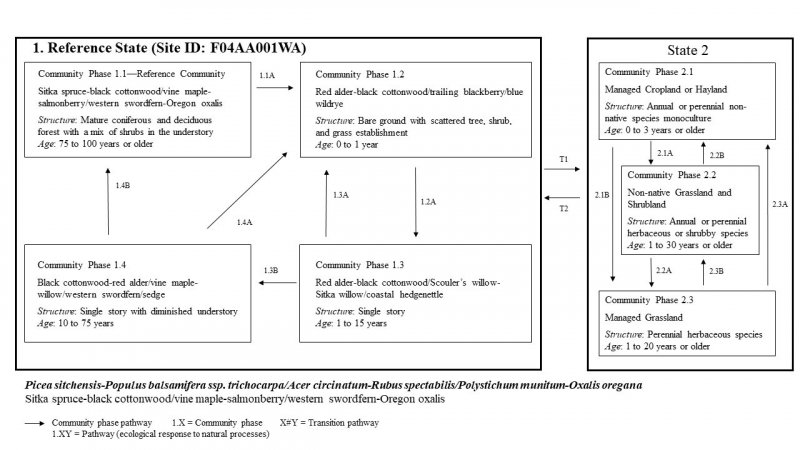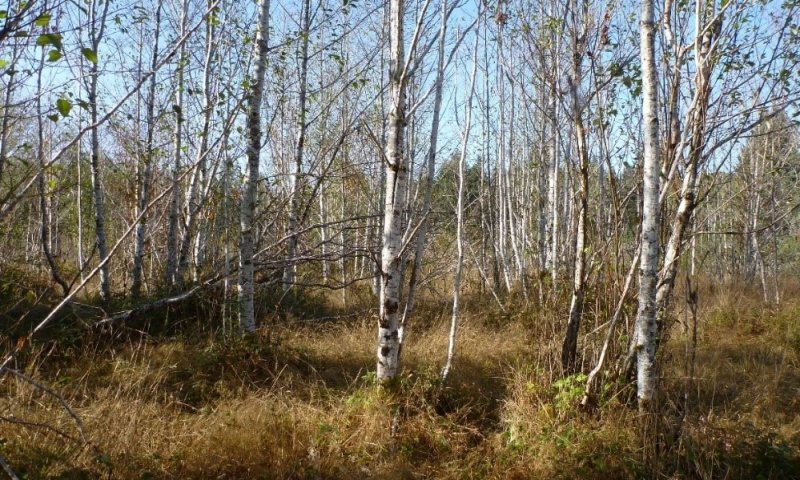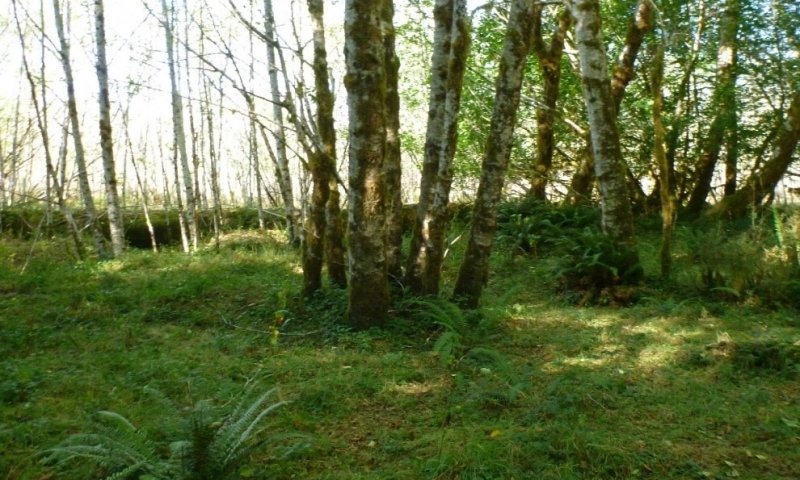Community 1.1
Sitka Spruce, Black Cottonwood, Vine Maple, Salmonberry, Western Swordfern, and Oregon Oxalis
Structure: Mature coniferous and deciduous forest with a mix of shrubs in the understory
Sitka spruce is the dominant overstory species in the reference community. Black cottonwood is long-living (up to 200 years) and remains a dominant deciduous species in the overstory along the riparian edge; however, regeneration is limited as the forest matures and the canopy cover increases. Red alder remains a major component in most mature stands, but it will start to actively decline after 40 to 70 years. Alder regeneration typically is limited to pockets of disturbance where sunlight is abundant (Balian, 2005). Western hemlock (typically in stands older than 100 years), bigleaf maple, and western redcedar (Thuja plicata) may be present in the stand. Herbivory on western hemlock and western redcedar by elk (Cervus elaphus) and black-tailed deer (Odocoeleus hemionus columbianus) may greatly impact the prominence of these species (Stolnack, 2010).
The reference community represents a lack of major flooding for at least 75 years, which allows the pioneering species to form a mature canopy. It also allows for growth of a vigorous understory of shrubs and forbs, including vine maple, salmonberry, western swordfern, and Oregon oxalis.
Common disturbances include small gap dynamics (1/2-acre openings or smaller) following the decline of the red alder canopy and minor scouring from flooding. Soil deposition following minor scouring from flooding temporarily affects the understory community, but it does not alter the composition of the overstory. Beaver (Castor canadensis) activity can by a significant driver in small-scale disturbances, affect hydrologic morphology, and contribute to large woody debris in riparian edges and corridors.
Dominant plant species
-
Sitka spruce (Picea sitchensis), tree
-
black cottonwood (Populus balsamifera ssp. trichocarpa), tree
-
red alder (Alnus rubra), tree
-
western hemlock (Tsuga heterophylla), tree
-
western redcedar (Thuja plicata), tree
-
bigleaf maple (Acer macrophyllum), tree
-
vine maple (Acer circinatum), shrub
-
salmonberry (Rubus spectabilis), shrub
-
western swordfern (Polystichum munitum), other herbaceous
-
redwood-sorrel (Oxalis oregana), other herbaceous
Community 1.2
Red Alder, Black Cottonwood, Trailing Blackberry, and Blue Wildrye
Structure: Bare ground with scattered tree, shrub, and grass establishment
Community phase 1.2 represents a riparian forest that is undergoing regeneration or stand initiation immediately following flooding. The soil surface is gravelly and highly variable depending on the intensity and frequency of flooding and aggradation from flooding (Fonda, 1974). Scattered remnant mature trees may be in some areas, and woody debris is abundant. Successful regeneration is dependent on the local seed source, an adequate seedbed, and sufficient light and water (Nierenberg, 2000). Red alder can establish quickly as compared to conifers. It can sprout and establish in full sunlight and fixes nitrogen in shallow flood plain soils, which provide an early competitive advantage (Villarin, 2009). Seeds of deciduous species are light and can be transported long distances by wind and water, allowing for rapid recolonization. Black cottonwood will establish quickly on gravel bars, and it commonly develops into a thick, even-aged stand. California blackberry (Rubus ursinus) and blue wildrye (Elymus glaucus) commonly are established in this community phase. Plant cover is relatively sparse; it ranges from 5 to 20 percent during this stage (Fonda, 1974). Introduced grass species such as creeping bentgrass (Agrostis stolonifera) may be present. Infestation by invasive species such as Japanese knotweed (Polygonum cuspidatum) and giant knotweed (Polygonum sachalinense) is a concern during this community phase.
Community 1.3
Red Alder, Black Cottonwood, Scouler’s Willow, Sitka Willow, and Coastal Hedgenettle
Structure: Single story
Community phase 1.3 is an early seral forest in regeneration. Scattered remnant mature trees may be present. Competition among individual trees for available water, light, and nutrients is increased. Red alder, black cottonwood, Sitka willow (Salix sitchensis), and Scouler’s willow (Salix scouleriana) are dominant in the overstory. California blackberry is a major component of the understory along with coastal hedgenettle (Stachys chamissonis) and Mexican hedgenettle (Stachys mexicana). The understory is grassy and a mixture of introduced and native species.
Community 1.4
Black Cottonwood, Red Alder, Vine Maple, Willow, Western Swordfern, and Sedge
Structure: Single story with diminished understory
Community phase 1.4 is a forest in the competitive exclusion stage. Scattered remnant mature trees may be present. Black cottonwood and red alder are dominant in the overstory. Red alder will begin to die 40 to 70 years following disturbance and more light will penetrate the newly nitrogen-rich soil (Naiman, 2009). As a result, conifer regeneration is more prevalent in this community phase.
Seedlings of Sitka spruce will begin to establish sporadically, especially in areas that have more shade. They may establish within 4 years of hardwood establishment (Stolnack, 2010). Downed logs, which are more prevalent in established stands, are an important component for conifer establishment (Villarin, 2009). About 60 to 90 years following disturbance, Sitka spruce begins to flourish and replace red alder (Van Pelt, 2006). Sitka spruce seedlings can survive small floods and inundation by producing adventitious roots from recently buried stems (Van Pelt, 2006).
During this phase, the canopy closure will mature to 100 percent and the understory will diminish. Some understory species that are better adapted to at least partial shade, such as vine maple and western swordfern, will begin to flourish in the community. Farther from the flood plain, the shrub community decreases and a closed-canopy forest develops (Villarin, 2009). If red alder regeneration is in this community phase, it may be inferred that frequent minor flooding has been influencing the site dynamics (Nierenberg, 2000). Over time, the forest begins to self-thin as a result of competition and a decrease in species that are intolerant of shade.
Pathway 1.1A
Community 1.1 to 1.2
This pathway represents a stand-replacing wildfire or major 100- or 500-year flood that scours the stream channel, removes understory and overstory vegetation, and may alter the streamflow. This type of disturbance may completely reconfigure sediment loads and dramatically reduce or eliminate the forest overstory.
Pathway 1.2A
Community 1.2 to 1.3
Red Alder, Black Cottonwood, Trailing Blackberry, and Blue Wildrye
Red Alder, Black Cottonwood, Scouler’s Willow, Sitka Willow, and Coastal Hedgenettle
This pathway represents growth over time with no further major disturbance.
Pathway 1.3A
Community 1.3 to 1.2
Red Alder, Black Cottonwood, Scouler’s Willow, Sitka Willow, and Coastal Hedgenettle
Red Alder, Black Cottonwood, Trailing Blackberry, and Blue Wildrye
This pathway represents a stand-replacing wildfire or a major 100- or 500-year flood that scours the stream channel, removes the understory and overstory vegetation, and may alter the streamflow. This type of disturbance may completely reconfigure sediment loads and dramatically reduce or eliminate the forest overstory.
Pathway 1.3B
Community 1.3 to 1.4
Red Alder, Black Cottonwood, Scouler’s Willow, Sitka Willow, and Coastal Hedgenettle
Black Cottonwood, Red Alder, Vine Maple, Willow, Western Swordfern, and Sedge
This pathway represents growth over time with no further major disturbance.
Pathway 1.4B
Community 1.4 to 1.1
This pathway represents an area with no further major disturbance. Continued growth over time and ongoing mortality lead to increased vertical diversification. The community begins to resemble the structure of the reference community, including small pockets of regeneration (both deciduous and coniferous species) and a more diversified understory.
Pathway 1.4A
Community 1.4 to 1.2
Black Cottonwood, Red Alder, Vine Maple, Willow, Western Swordfern, and Sedge
Red Alder, Black Cottonwood, Trailing Blackberry, and Blue Wildrye
This pathway represents a stand-replacing wildfire or a major 100- or 500-year flood that scours the stream channel, removes the understory and overstory vegetation, and may alter the streamflow. This type of disturbance may completely reconfigure sediment loads and dramatically reduce or eliminate the forest overstory.
Community 2.1
Managed Cropland or Hayland
Community Phase 2.1 may consist of a range of crops, including annually planted species, short-lived perennial species, and more permanent shrubby species. Hay and grasses and legumes for silage are included in this community phase.
Structure: Annual or perennial non-native species monoculture
Community 2.2
Non-Native Grassland and Shrubland
Community phase 2.2 is characterized by low-level agronomic or management activity such as adding fertility, intensive grazing management, regular mowing, or weed control. This plant community commonly consists dominantly of introduced weedy species. Areas that have extremely low fertility or are subject to heavy grazing pressure have a higher proportion of annual, stoloniferous, or rhizomatous species. Wetland areas commonly support dominantly non-native rhizomatous grasses. The plant community may include remnants of introduced pasture species that commonly are seeded.
Structure: Annual or perennial herbaceous or shrubby species
Community 2.3
Managed Grassland
Community phase 2.3 receives regular agronomic inputs, including adding soil nutrients and other soil amendments such as lime, implementing grazing management plans or regular mowing, controlling weeds, and reseeding as needed. This plant community typically includes introduced perennial pasture and hay species that commonly are seeded. In areas of historic native grassland, mixtures of perennial and annual native species may be seeded and managed by appropriate agronomic and livestock management activities. Minor amounts of introduced species that commonly are in non-native grassland and shrub communities (community phase 2.2) are in this phase.
Structure: Perennial herbaceous species
Pathway 2.1A
Community 2.1 to 2.2
In the absence of agronomic and livestock management activities, seeds from surrounding weedy plant communities will be transported to the site by wind, flood water, animals, or vehicle traffic. Adapted species will become established. Management activities include tilling, adding soil nutrients and other soil amendments such as lime, mowing, burning, harvesting or chemically controlling vegetation, planting to desirable herbaceous species, and implementing grazing management plans.
Pathway 2.1B
Community 2.1 to 2.3
This pathway represents agronomic and livestock management activities, including tilling, adding soil nutrients and other soil amendments such as lime, mowing, burning, harvesting or chemically controlling vegetation, planting to desirable herbaceous species, and implementing grazing management plans.
Pathway 2.2B
Community 2.2 to 2.1
This pathway represents agronomic activities such as tilling, adding soil nutrients and other soil amendments such as lime, mowing, burning, harvesting or chemically controlling vegetation, and planting to desirable crop species.
Pathway 2.2A
Community 2.2 to 2.3
This pathway represents agronomic and livestock management activities, including tilling, adding soil nutrients and other soil amendments such as lime, mowing, burning, harvesting or chemically controlling vegetation, planting to desirable herbaceous species, and implementing grazing management plans.
Pathway 2.3A
Community 2.3 to 2.1
This pathway represents agronomic activities, including tilling, adding soil nutrients and other soil amendments such as lime, mowing, burning, harvesting or chemically controlling vegetation, and planting to desirable crop species.
Pathway 2.3B
Community 2.3 to 2.2
In the absence of agronomic and livestock management activities, seeds from surrounding weedy plant communities will be transported to the area by wind, floodwater, animals, or vehicle traffic. Adapted species will become established. Management activities include tilling, adding soil nutrients and other soil amendments such as lime, mowing, burning, harvesting or chemically controlling vegetation, planting to desirable herbaceous species, and implementing grazing management plans.
Transition T1A
State 1 to 2
This pathway represents a change in land use, including modifications to the hydrologic function to develop pasture and agriculture. Non-native seed disbursement is introduced (intentionally or unintentionally), which alters the reference community.
Restoration pathway T2A
State 2 to 1
This pathway represents restoration of the natural hydrologic function and native plant habitat. Native seed sources and extensive management and mitigation of brush and invasive species are needed to restore the community.
